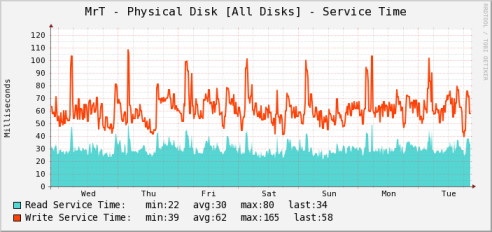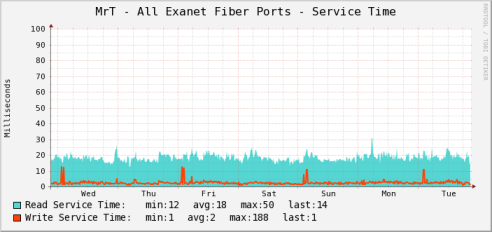Since the announcement of thin provisioning built into vSphere I have seen quite a few blog posts on how to take advantage of it but haven’t seen anything that matches my strategy which has served me well utilizing array-based thin provisioning technology. I think it’s pretty foolproof..
The man caveat is that I assume you have a decent amount of storage available on your system, that is your VMFS volumes aren’t the only thing residing on your storage. On my current storage array,written VMFS data accounts for maybe 2-3 % of my storage. On the storage array I had at my last company it was probably 10-15%. I don’t believe in dedicated storage arrays myself. I prefer nice shared storage systems that can sustain random and sequential I/O from any number of hosts and distributed that I/O across all of the resources for maximum efficiency. So my current array has most of it’s space set aside for a NFS cluster, and then there is a couple dozen terabytes set aside for SQL servers and VMware. The main key is being able to share the same spindles across dozens or even hundreds of LUNs.
There has been a lot of debate over the recent years about how best to size your VMFS volumes. The most recent data I have seen suggests somewhere between 250GB and 500GB. There seems to be unanimous opinion out there not to do something crazy and use 2TB volumes. The exact size depends on your setup. How many VMs, how many hosts, how often you use snapshots, how often you do vMotion, as well as the amount of I/O that goes on. The less of all of those the larger the volume can potentially be.
My method is so simple. I chose 1TB as my volume sizes, thin provisioned of course. I utilize the default lazy zero VMFS mode and do not explicitly turn on thin provisioning on any VMDK files. There’s no real point if you already have it in the array. So I create 1TB volumes, and I begin creating VMs on them. I try to stop when I get to around 500GB of allocated(but not written) space. That is VMware thinks it is using 500GB, but it may only be using 30GB. This way I know, the system will never use more than 500GB. Pretty simple. Of course I have enough space in reserve that if something crazy were to happen the volume could grow to 500GB and not cause any problems. Even with my current storage array operating in the neighborhood of 89% of total capacity, that still leaves me with several terabytes of space I can use in an emergency.
If I so desire I can go beyond the 500GB at any time without an issue. If I chose not to then I haven’t wasted any space because nothing is written to those blocks. My thin provisioning system is licensed based on written data, so if I have 10TB of thin provisioning on my system I can, if I want create 100TB of thin provisioned volumes, provided I don’t write more than 10TB to them. So you see there really is no loss in making a larger volume when the data is thin provisioned on the array. Why not make it 2TB or even bigger? Well really I can’t see a time when I would EVER want a 2TB VMFS volume which is why I picked 1TB.
I took the time in my early days working with thin provisioning to learn the growth trends of various applications and how best to utilize them to get maximum gain out of thin provisioning. With VMs that means having a small dedicated disk for OS and swap, and any data resides on other VMDKs or preferably on a NAS or for databases on raw devices(for snapshot purposes). Given that core OSs don’t grow much there isn’t much space needed(I default to 8GB) for the OS, and I give the OS a 1GB swap partition. For additional VMDKs or raw devices I always use LVM. I use it to assist me in automatically detecting what devices a particular volume are on, I use it for naming purposes, and I use it to forcefully contain growth. Some applications are not thin provisioning friendly but I’d like to be able to expand the volume on demand without an outage. Online LVM resize and file system resize allows this without touching the array. It really doesn’t take much work.
On my systems I don’t really do vMotion(not licensed), I very rarely use VMFS snapshots(few times a year), the I/O on my VMFS volumes is tiny despite having 300+ VMs running on them. So in theory I probably could get away with 1TB or even 2TB VMFS volume sizes, but why lock myself into that if I don’t have to? So I don’t.
I also use dedicated swap VMFS volumes so I can monitor the amount of I/O going on with swap from an array perspective. Currently I have 21 VMware hosts connected to our array totalling 168 CPU cores, and 795GB of memory. Working to retire our main production VMware hosts, many of which are several years old(re-purposed from other applications). Now that I’ve proven how well it can work on existing hardware and the low cost version the company is ready to gear up a bit more and commit more resources to a more formalized deployment utilizing the latest hardware and software technology. You won’t catch me using the enterprise plus or even the enterprise version of VMware though, cost/ benefit isn’t there.

